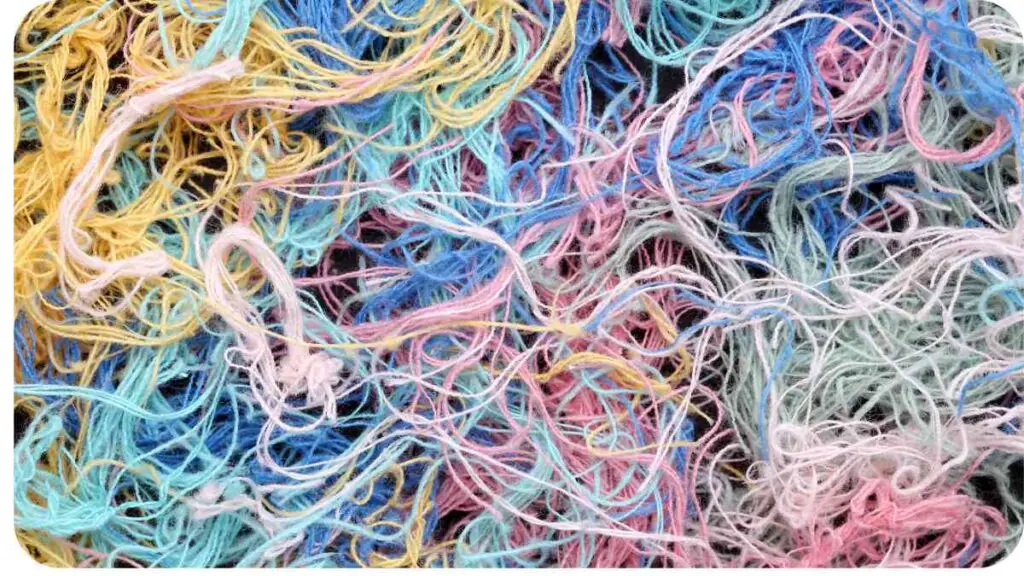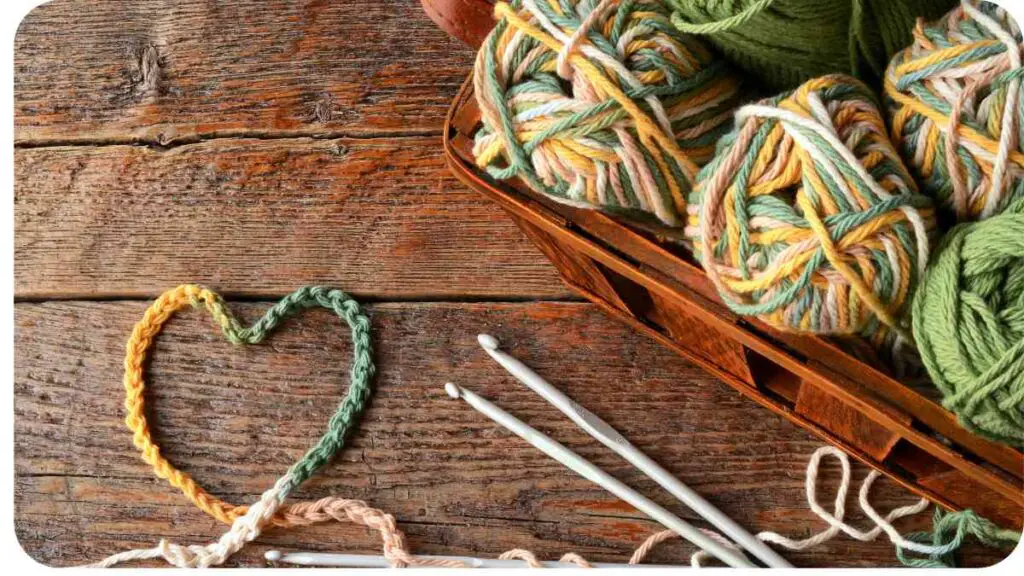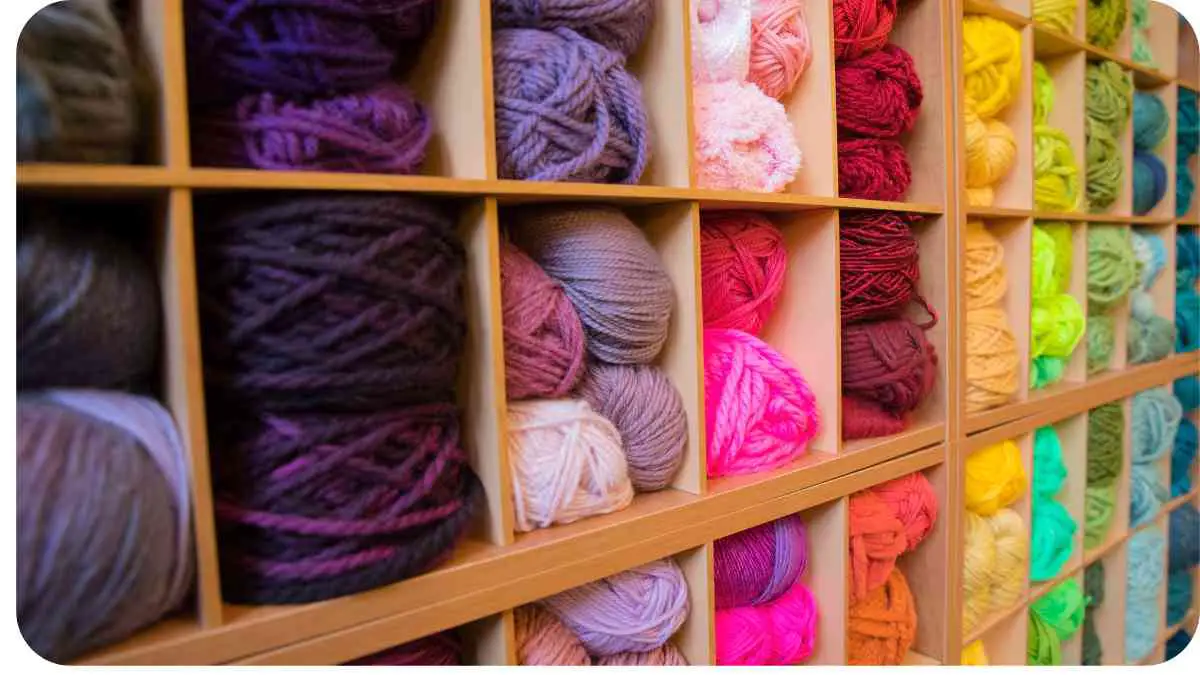Are you tired of your yarn constantly tangling while knitting or crocheting? You’re not alone! Yarn tangling can be frustrating and time-consuming, but fear not! In this article, we’ll provide you with valuable troubleshooting tips to help you prevent yarn tangling and make your crafting experience more enjoyable.
As a seasoned yarn enthusiast with years of experience, I’ve encountered my fair share of tangled yarn situations. Through trial and error, I’ve learned various techniques, explored different yarns, and discovered ways to minimize tangling. I’m excited to share my expertise and personal insights with you so that you can avoid yarn tangling woes.
| Takeaways |
|---|
| Proper yarn storage is essential for preventing tangling. Keep your yarn in a clean and dry environment. |
| Using yarn guides, bowls, or other tools can help maintain a tangle-free yarn flow while crafting. |
| Techniques such as consistent tension, working with smaller sections, and keeping your work area organized can prevent tangling. |
| Unwinding yarn properly, by pulling from the center or using a yarn winder, can minimize tangles as you work. |
| If you encounter yarn tangling, pause, assess the situation, and gently work through the tangle to avoid making it worse. |
| Blocking your finished work can help set the stitches in place and prevent future tangling. |
| Organizing your yarn stash and keeping snippets of yarn for color matching or repairs can contribute to a smoother crafting experience. |
| Minimize excessive handling of yarn and ensure clean hands to prevent introducing dust or oils that can lead to tangling. |
| Using yarn bobbins or cardboard tubes can aid in handling multiple colors or frequent yarn changes without causing tangles. |
| Explore further resources and FAQs for more tips and solutions to prevent and troubleshoot yarn tangling. |
2. Understanding Yarn Tangling
Before we delve into the troubleshooting tips, let’s first gain a better understanding of yarn tangling, its causes, and its effects.
2.1 Causes of Yarn Tangling

Yarn tangling can occur due to multiple factors, including:
- Poor yarn preparation: Improper winding or storage can lead to tangled yarn.
- Incorrect handling: Inadequate tension control and mishandling of yarn can contribute to tangling.
- Yarn characteristics: Some yarn types or textures are more prone to tangling than others.
“When tackling a crochet project, remember to consult the Tips and Tricks section for guidance. Properly following a pattern can save you from yarn tangling troubles down the line.”
2.2 Effects of Yarn Tangling
The consequences of yarn tangling go beyond mere frustration. They can disrupt your knitting or crochet flow, waste your precious time, and even impact the quality of your finished projects. It’s essential to address this issue to ensure a seamless crafting experience.
Now that we’ve established what yarn tangling is and its underlying causes, let’s move on to the key steps you can take to prevent it.
3. Preparing Your Yarn
Proper preparation of your yarn sets the foundation for a tangle-free crafting session. Here are some essential steps to follow.
3.1 Choosing the Right Yarn
Selecting the appropriate yarn for your project can significantly reduce the chance of tangling. Consider the yarn’s properties, such as its fiber content, thickness, and ply. Some yarns, like slippery silk or loosely spun fibers, are more prone to tangling. Opting for yarns with tighter twists or natural fibers like wool can be a wise choice.
Furthermore, consider the project itself. For intricate lacework or fine details, opt for smoother yarns that glide smoothly on your needles or hook.
“Organization matters in preventing yarn tangles. Explore our guide on Yarn Storage for tips on maintaining a tidy workspace and ensuring smoother crafting sessions.”
3.2 Winding Yarn into a Ball
Before starting your project, wind your yarn into a ball using a yarn winder or manually. This helps remove any knots or tangles that might be present in the skein. Ensure a smooth winding process, and you’ll have a better chance of preventing tangling during your crafting session.
To keep your yarn ball organized, consider using a yarn bowl or placing it in a yarn holder that allows the ball to rotate freely, preventing unnecessary friction and tangles.
| Brand | Type | Price |
| YarnWinder Pro | Electronic | $29.99 |
| HandyYarn Winder | Manual | $14.99 |
| SpinMeRightRound | Yarn Bowl | $19.99 |
| YarnKeeper Deluxe | Yarn Holder | $12.99 |
These tools can make the yarn preparation process easier and more efficient.
4. Handling Yarn Correctly

Once you have prepared your yarn, it’s essential to handle it correctly while working on your project. Proper handling techniques can help prevent tangles and ensure a smooth crafting experience.
4.1 Yarn Storage
Storing your yarn properly is crucial in preventing tangling. Keep your yarn in a clean and dry environment, away from pets and dust. Consider using storage solutions like plastic bins or clear bags that allow you to easily identify and access your yarn stash without causing tangles.
You can also use yarn organizers or hanging shelves to keep your yarn neatly arranged and prevent it from tangling with other skeins. These simple storage solutions can go a long way in maintaining the integrity of your yarn and preventing unnecessary knots.
4.2 Managing Tension
Maintaining consistent tension while working with yarn is vital. Tension that is too loose or too tight can contribute to tangles. Experiment with different tension techniques to find the one that works best for you.
One effective way to manage tension is by using a yarn guide. A yarn guide is a small tool that attaches to your finger or the base of your knitting needles/crochet hook, ensuring the yarn flows smoothly and evenly. This helps minimize the chances of the yarn tangling due to inconsistent tension.
“While this guide primarily addresses knitting, it offers insights into untangling yarn snarls. Check out our Comprehensive Guide for valuable troubleshooting techniques.”
4.3 Avoiding Knots and Snags
During the crafting process, it’s important to be mindful of potential knots and snags that can lead to yarn tangling. Check the yarn regularly for any knots or loose ends that could get caught while you’re working. Untangle any knots immediately to prevent further complications.
Additionally, be cautious of sharp or rough surfaces that may snag your yarn. Smooth out rough edges on your crafting tools and make sure your workspace is free of any snags to avoid unnecessary tangling.
4.4 Unwinding Yarn Properly
If you’re using a larger skein or hank of yarn, it’s crucial to unwind it properly to prevent tangling. Instead of unraveling the yarn from the outside, locate the yarn end that is tucked inside and gently pull from there. This method ensures a controlled release of the yarn and minimizes the risk of creating knots or tangles as you work your way through the skein.
Remember, the key to preventing tangles while handling yarn is to be aware of your movements and take small preventive steps along the way.
5. Working with Yarn
Now that we’ve covered yarn preparation and handling, let’s focus on techniques that can help you work with yarn more efficiently and prevent tangling.
5.1 Using Yarn Guides and Bowls
Yarn guides and bowls are excellent tools for maintaining a tangle-free yarn flow while knitting or crocheting. Yarn guides can be attached to your finger or the base of your needles or hook, keeping the yarn in place and reducing friction. This allows for smoother and more controlled yarn movement.
Yarn bowls, on the other hand, provide a stable and secure place to hold your yarn while you work. The bowl’s design ensures that the yarn unwinds smoothly without creating unnecessary tangles. The use of yarn guides and bowls can significantly enhance your crafting experience and minimize the chances of tangling.
5.2 Techniques for Tangle-Free Crochet or Knitting
Using the right techniques while crafting can make a significant difference in preventing yarn tangling. Here are a few tips to keep in mind:
- Maintain consistent tension: Tension plays a crucial role in preventing tangles. Practice maintaining a steady tension throughout your project to keep the yarn flowing smoothly.
- Work with smaller sections: Instead of working with a large amount of yarn at once, consider dividing it into smaller, more manageable sections. This reduces the likelihood of tangling and allows for better control.
- Keep your work area organized: Clear your work area from unnecessary clutter and keep your tools neatly arranged. This creates a conducive environment for tangle-free crafting.
- Watch your stitches: Pay attention to the stitches you’re creating. Be mindful of any snags or twists in the yarn and correct them immediately to avoid further tangling.
By incorporating these techniques into your crafting routine, you can enjoy a more seamless and frustration-free experience.
6. Troubleshooting Common Issues
Even with the best preparation and techniques, yarn tangling issues can still arise. Here are some common issues you may encounter and troubleshooting tips to help you overcome them.
6.1 Yarn Splitting
Yarn splitting occurs when the strands of yarn separate, making it difficult to work with and resulting in a messy appearance. To prevent yarn splitting, consider the following:
- Opt for yarn with tighter twists as they are less prone to splitting.
- Use sharper needles or hooks to create cleaner entry points and reduce the chances of splitting.
- Be mindful of your tension. Tension that is too tight can increase the likelihood of splitting.
“Don’t let yarn pilling lead to more knots and snags. Learn how to combat it with our Fixing Tips and keep your yarn smooth and tangle-free for your projects.”
6.2 Yarn Twist
Yarn twist refers to the natural twist or spiral of the yarn fibers. Sometimes, the twist in the yarn can cause it to tangle. To address this issue:
- When working with yarn that tends to twist, periodically let the yarn hang freely to allow it to unwind and release any built-up twist.
- If you notice excessive twisting, consider winding the yarn into a center-pull ball instead of using the skein directly. This prevents the yarn from twisting as you work.
6.3 Preventing Yarn from Unraveling
Loose ends or unraveling yarn can lead to tangling and frustration. To prevent this:
- Secure loose ends with a knot or weave them back into the project as you go.
- If you’re taking a break from your project, use yarn stoppers or rubber bands to keep the ends in place.
6.4 Tangled Yarn in Projects
Despite your best efforts, you may encounter tangled yarn within your projects. Here’s how to handle it:
- Pause and assess the situation. Do not pull or yank on the tangled portion, as this can make the situation worse.
- Gently work through the tangle, using your fingers or a crochet hook to separate the strands.
- If the tangle is too intricate or challenging, consider cutting the yarn and rejoining it. However, use this option as a last resort.
Remember, patience and a calm approach can go a long way in untangling yarn and salvaging your project.
7. Additional Tips and Tricks
In addition to the troubleshooting tips provided earlier, here are some extra tips and tricks to help you prevent yarn tangling and make your yarn crafting journey smoother:
- Blocking Your Finished Work: Blocking is a process that helps shape and relax your knitted or crocheted projects. Proper blocking can enhance the overall appearance of your work and prevent future tangling by setting the stitches in place. Follow the instructions for blocking specific to your project and yarn type.
- Organizing Your Yarn Stash: A well-organized yarn stash can save you time and prevent tangling. Consider storing your yarn by color, weight, or project type to easily locate and access specific yarn. Using storage solutions like transparent containers, shelves, or hanging organizers can help you maintain an organized and tangle-free yarn collection.
- Keep Snippets of Yarn: Retaining small snippets of yarn from your projects can be useful for color matching, repairs, or future reference. Label each snippet with the yarn name, brand, and color code, and store them in a small labeled container. This way, when you need to match a specific color or replace a yarn in the future, you’ll have a handy reference.
- Avoid Excessive Yarn Handling: Frequent touching and handling of yarn can introduce dust, oils, and dirt, which can lead to tangling. Minimize excessive handling and ensure your hands are clean before starting a project. If you have sweaty hands or use hand creams, you might consider using a hand cream that doesn’t leave a greasy residue.
- Use Yarn Bobbins or Cardboard Tubes: For projects that involve multiple colors or require frequent yarn changes, consider using yarn bobbins or winding the secondary colors onto cardboard tubes. This keeps the different yarns separated and prevents tangles during colorwork.
Incorporating these additional tips and tricks into your yarn crafting routine can contribute to a more organized, efficient, and tangle-free experience.
“Is your crochet project curling at the edges? Follow our Quick Guide to prevent curling and, in turn, reduce the chances of yarn tangling during your work.”
Further Reading
Here are some additional resources you can explore to learn more about preventing yarn tangling and improving your yarn crafting experience:
- 43 Ways to Keep Your Yarn Tangle-Free: This article provides an extensive list of tips and techniques to keep your yarn tangle-free while crocheting. It covers various aspects, including yarn maintenance, project organization, and tension control.
- Prevent Your Yarn from Tangling: This informative blog post discusses common causes of yarn tangling and provides practical tips to prevent it. It also includes suggestions for organizing your yarn stash and optimizing your crafting environment.
- How to Keep Yarn from Tangling: This resource offers valuable insights into preventing yarn tangling, focusing on proper yarn handling, tension control, and storage techniques. It also provides useful tips for unraveling tangled yarn and salvaging projects.
FAQs
Here are some frequently asked questions related to preventing yarn tangling, along with their answers:
How can I prevent yarn from tangling while knitting or crocheting?
There are several steps you can take to prevent yarn tangling. These include choosing the right yarn, winding it properly, managing tension, avoiding knots and snags, and using tools like yarn guides or bowls to keep the yarn flowing smoothly.
What should I do if I encounter a tangled yarn mess in my project?
If you encounter a tangled yarn mess, avoid pulling or yanking on it, as that can make the situation worse. Instead, take a calm and patient approach. Gently work through the tangle using your fingers or a crochet hook to separate the strands. If needed, consider cutting the yarn and rejoining it as a last resort.
Is there a specific type of yarn that is less prone to tangling?
Some yarns are less prone to tangling than others. Yarns with tighter twists or natural fibers like wool tend to be less likely to tangle. However, it’s important to consider the specific project requirements and choose a yarn that suits both the project and your personal preferences.
Can I prevent yarn splitting while working?
To prevent yarn splitting, consider using yarn with tighter twists and sharper needles or hooks. Also, be mindful of your tension. A tension that is too tight can increase the chances of yarn splitting.
How do I store my yarn to prevent tangling?
To prevent tangling during storage, keep your yarn in a clean and dry environment, away from pets and dust. Consider using storage solutions like plastic bins or clear bags to keep your yarn organized and easily accessible. You can also use yarn organizers or hanging shelves to prevent your yarn from tangling with other skeins.
These FAQs should provide answers to some common queries about dealing with yarn tangling. Don’t hesitate to explore these questions in more detail or seek additional resources if needed.

My name is Hellen James, and I’m a crochet and knitting expert. I’ve been crocheting since I was just a kid, but I started taking it seriously when I realized that it was a great way to de-stress and relax. Now that I have kids of my own, I love teaching them how to do it too!

